Master the complexities of heavy haul loads. Our guide covers permits, equipment, and costs for shipping oversized freight. Get your free quote today!
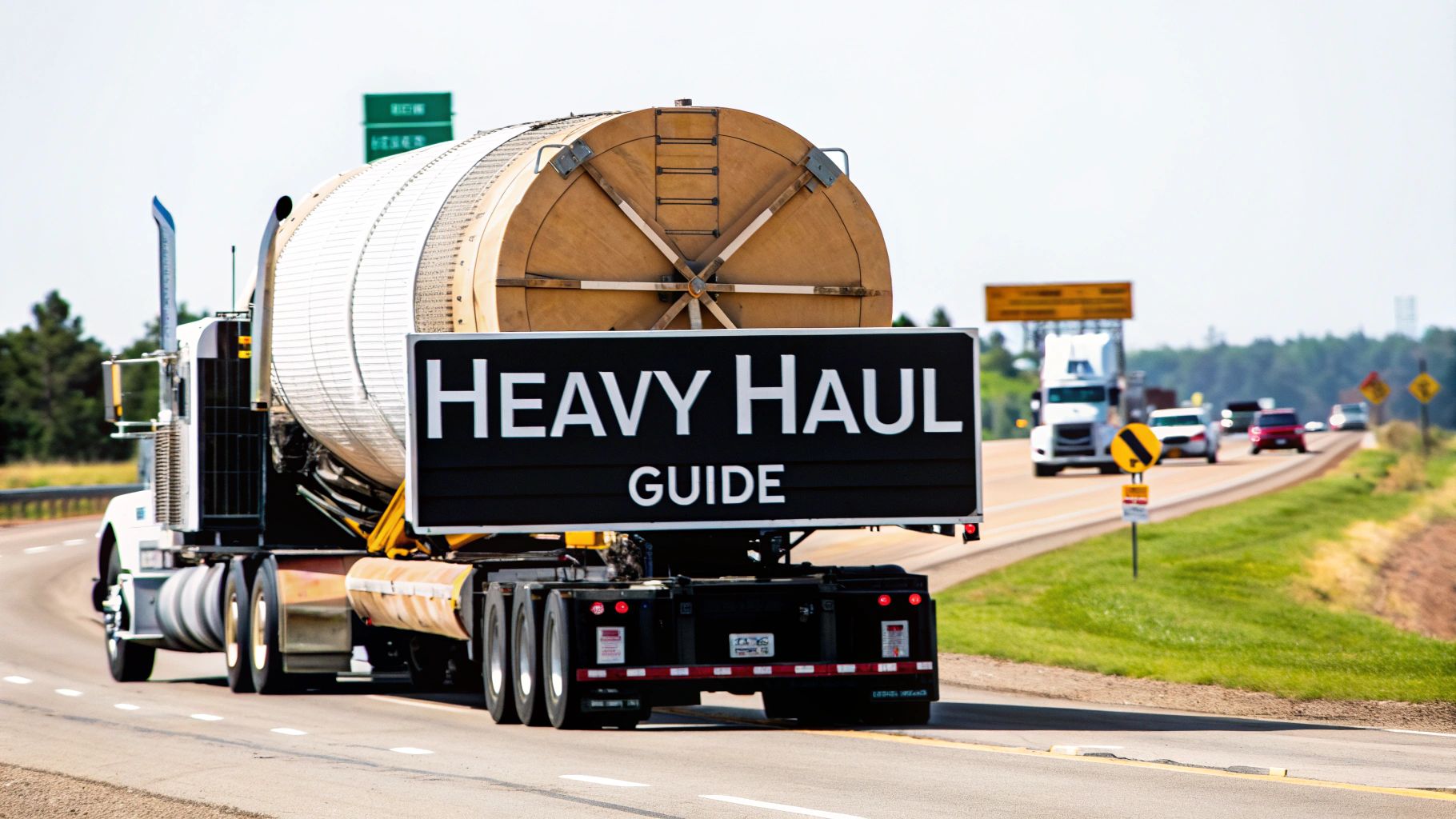
Think of it this way: moving the furniture out of your house is standard freight. Moving the entire house? That’s heavy haul.
A heavy haul load is any shipment that’s too big or too heavy for standard regulations. It's a whole different ballgame that requires specialized permits, unique equipment, and a serious amount of planning before the wheels ever start turning.
When your cargo can't fit into a standard 53-foot trailer, you’ve officially entered the world of heavy haul. This isn't just about shipping big boxes; it’s the logistics behind moving the titans of industry—the massive construction machinery, giant wind turbine blades, and heavy-duty industrial equipment that form the backbone of our economy.
Unlike a regular full truckload (FTL) or less-than-truckload (LTL) shipment that fits neatly within legal road limits, a heavy haul shipment breaks the mold. So, what’s the official line? A load is considered heavy haul if it crosses any of these thresholds:
If your shipment ticks even one of these boxes, you can't just load up and go. The game completely changes, and meticulous, expert-level planning becomes non-negotiable.
It’s easy to lump all these massive shipments together, but in the industry, we get more specific. You’ll hear terms like oversized, overweight, and superload, and they aren't interchangeable. Each has its own unique challenges.
A wind turbine blade, for instance, might be incredibly long but not particularly heavy for its size. That makes it an oversized load. On the flip side, a compact industrial generator could be small enough to fit on a standard trailer but be so dense that it blows past the weight limit. That’s an overweight load.
Then you have the superload. These are the true giants of the road, freight that is so massive it dwarfs even typical oversized limits. Moving a superload is a massive undertaking that often requires police escorts, temporary road closures, and even coordination with utility companies to move power lines.
This entire process is a delicate balancing act. The infographic below really nails how a load's size, the necessary permits, and the available routes are all tangled together.
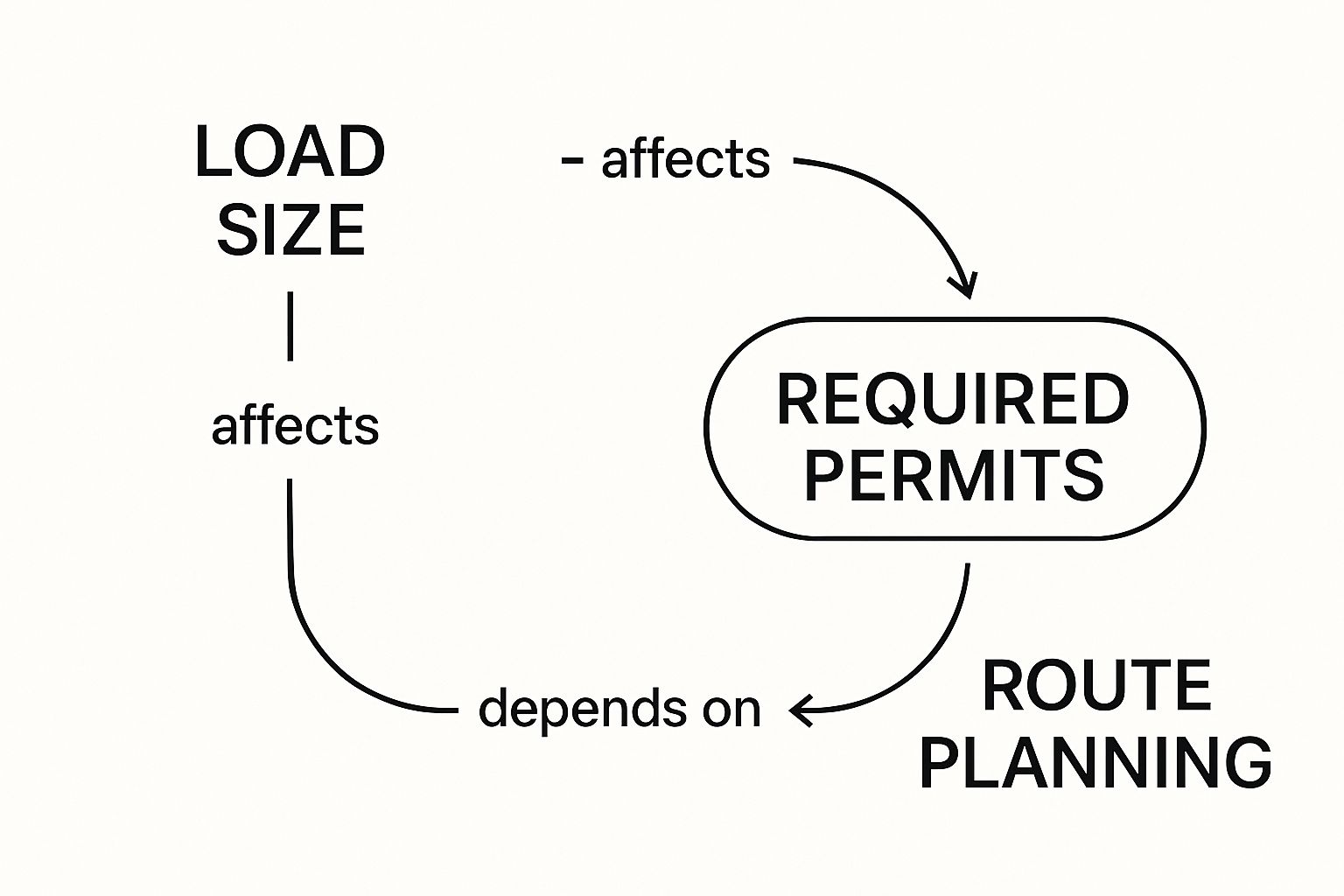
As you can see, you can't change one piece of the puzzle without affecting the others. It’s a constant cycle of adjustments that highlights just how complex a successful heavy haul shipment is.
To put it all in perspective, here's a simple breakdown of how heavy haul stacks up against the everyday freight shipping most people are familiar with.
This table offers a clear, side-by-side look at what separates standard truckload shipping from the specialized world of heavy haul transport.
The key takeaway is that while standard freight is about efficiency and volume, heavy haul is all about precision, safety, and navigating a mountain of regulations.
The need to move these colossal items is only getting bigger. Driven by global infrastructure projects and industrial growth, the heavy transport market was valued at around $150 billion in 2025.
And it’s not slowing down. Projections show a strong Compound Annual Growth Rate (CAGR) of 7% from 2025 to 2033, a testament to how crucial this service is. You can dig deeper into these figures in recent heavy transport market research.
No matter if your shipment is a simple FTL or a complex heavy haul project, having the right logistics partner makes all the difference.
If you're new to heavy haul, navigating the world of permits can feel like you’re trying to solve a puzzle where the pieces change shape every time you cross a state line. But these regulations aren't just bureaucratic red tape; they're critical safety rules put in place to protect our roads, bridges, and the public from the massive stress these loads create.
Think of it this way: you can drive a Toyota Camry on just about any road. But you wouldn't dare try to drive a battle tank over a small wooden bridge. That's what permits are for—they're the official green light that confirms the route is safe and strong enough for your specific shipment.
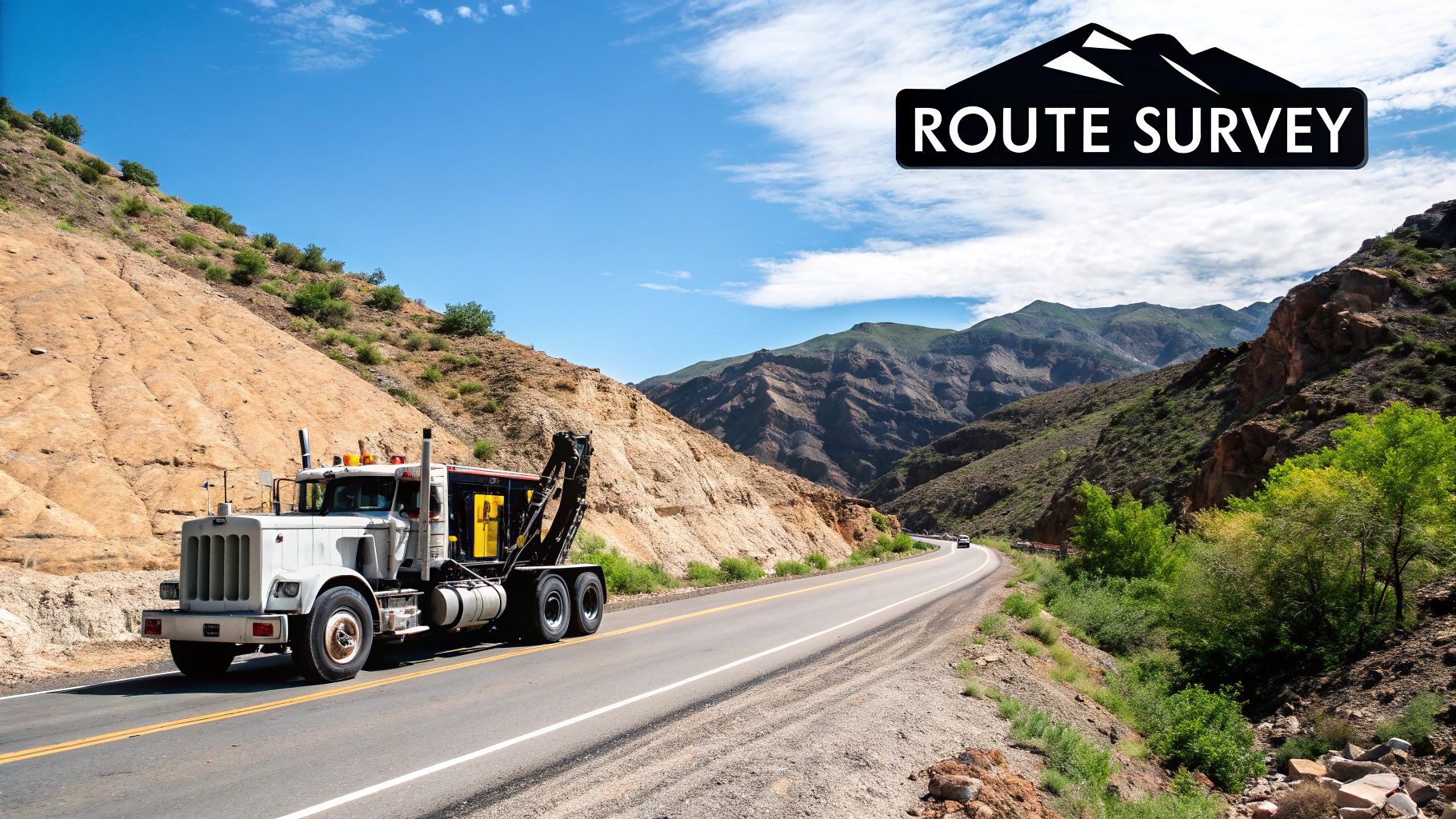
Here's one of the biggest headaches in heavy haul shipping: there’s no single, nationwide permit. Nope. Each state has its own rulebook, creating a complex patchwork of regulations that can change the second a truck crosses the border. A load that’s perfectly legal in Texas might suddenly need different permits, a new route, and even pilot cars to get through Louisiana.
This is exactly why having a logistics partner who lives and breathes this stuff is a game-changer. They're the experts who know how to navigate this legal maze, making sure every single mile of the journey is by the book.
Just as no two heavy haul loads are the same, permits aren't one-size-fits-all either. They're categorized to handle the specific challenges your freight presents. Getting a handle on these different types is the first step to a smooth, compliant shipment.
The sheer complexity of getting the right permits, especially for a multi-state haul, is the number one reason you shouldn't try to manage this alone. A single mistake can lead to crippling fines, your shipment being impounded, and genuinely dangerous situations on the road.
Don't let permit confusion delay your shipment. We handle the paperwork so you can focus on your business. Whether you need an LTL or FTL freight quote, we can provide a free, instant estimate.
Beyond the permit itself, states also enforce a whole host of practical, on-the-ground restrictions. These rules are all about minimizing traffic jams and keeping everyone on the road safe when a behemoth is sharing their lane.
Common State-Level Restrictions:
While heavy haul has its own special permits, it’s important to remember that all the normal rules of the road still apply. Understanding the general Florida state driving laws, for example, is still a basic requirement for any driver, showing how different layers of regulation work together.
Choosing the right trailer for a heavy haul load is a bit like a surgeon picking the perfect tool for a critical operation. The wrong choice isn't just a minor hiccup—it's a recipe for failure. This isn't a one-size-fits-all game; the equipment we use is as specialized and powerful as the cargo it’s moving.
Let's break it down with a simple analogy. Think of a standard flatbed trailer as your trusty pickup truck. It's versatile and great for a lot of jobs, but it definitely has its limits. A step-deck (or drop-deck) trailer is like a truck with a lower bed, making it easier to haul taller items without worrying about hitting an overpass.
But when you get into true heavy haul territory, you need the industry's powerhouse: the Removable Gooseneck (RGN) trailer. This is the low-riding champion. Its front portion actually detaches, creating a built-in ramp that lets massive, drivable machinery like bulldozers, excavators, and cranes roll right on and off.
Getting this match right—the equipment to the freight—is the absolute cornerstone of a successful shipment. It directly impacts safety, cost, and whether your cargo shows up on time and in one piece.
Not sure what kind of trailer your shipment needs? We can figure that out for you. Get a free, instant quote for your FTL or LTL freight today.
The real magic behind moving incredibly heavy things isn't just about having a beefy trailer frame; it’s all about the axles. Each axle is a point of contact with the road, and adding more of them is how we spread out immense weight safely. This simple principle protects the trailer, the cargo, and just as importantly, the road itself.
As a load gets heavier, the number of axles required goes up. It's a direct relationship that dictates the entire equipment setup. For perspective, a standard truck-and-trailer combo has five axles and is generally good for loads up to about 55,000 pounds.
Once you cross that line, the configurations start to get a lot more interesting.
As the weight climbs, the trailer setups become more complex, often involving extra modular components to add more axles where they're needed. Here’s a quick look at how the equipment typically scales with the load:
These configurations are highly technical and have to comply with a web of different state regulations. For any serious heavy haul shipment, you absolutely need to work with an expert who knows how to source the right multi-axle combination.
The entire trucking industry is a massive economic engine, and the specialized heavy haul sector is a key part of it. The global trucking market is valued at a staggering $2.2 trillion, with 13 million large trucks operating in the U.S. alone. And it's not standing still—the electric truck industry is projected to grow from $5.92 billion in 2025 to $38.76 billion by 2032. You can dive deeper into these fascinating trucking industry statistics to see where things are headed.
Sometimes, a load is so big or heavy that it needs a truly unique solution. For the absolute heaviest freight—think massive industrial vessels or power plant generators weighing over 200,000 pounds—carriers bring out the “dual-lane” trailers. These are so wide they literally occupy two full lanes of a highway.
For the most extreme loads, often pushing past 400,000 pounds, modular line trailers are the only answer. These incredible platforms allow for axles to be added or removed as needed, creating custom configurations with up to 36 axles that can be engineered to handle almost any weight imaginable.
Let our experts take the guesswork out of it and match your load with the perfect carrier and equipment.
When you're dealing with a heavy haul load, forget about plugging an address into Google Maps and hitting 'go.' That familiar blue line on your screen is completely useless here. Instead, route planning becomes an incredibly detailed, high-stakes mission that can single-handedly make or break the entire shipment.
Think of it this way: planning a normal freight run is like a casual road trip, but planning a heavy haul is like orchestrating a presidential motorcade. One allows for detours and a bit of spontaneity; the other demands that every single variable is accounted for, from the structural integrity of a bridge right down to the exact height of a traffic light.
For a heavy haul, the route isn't just a suggestion—it's the blueprint for a safe, legal, and on-time delivery.
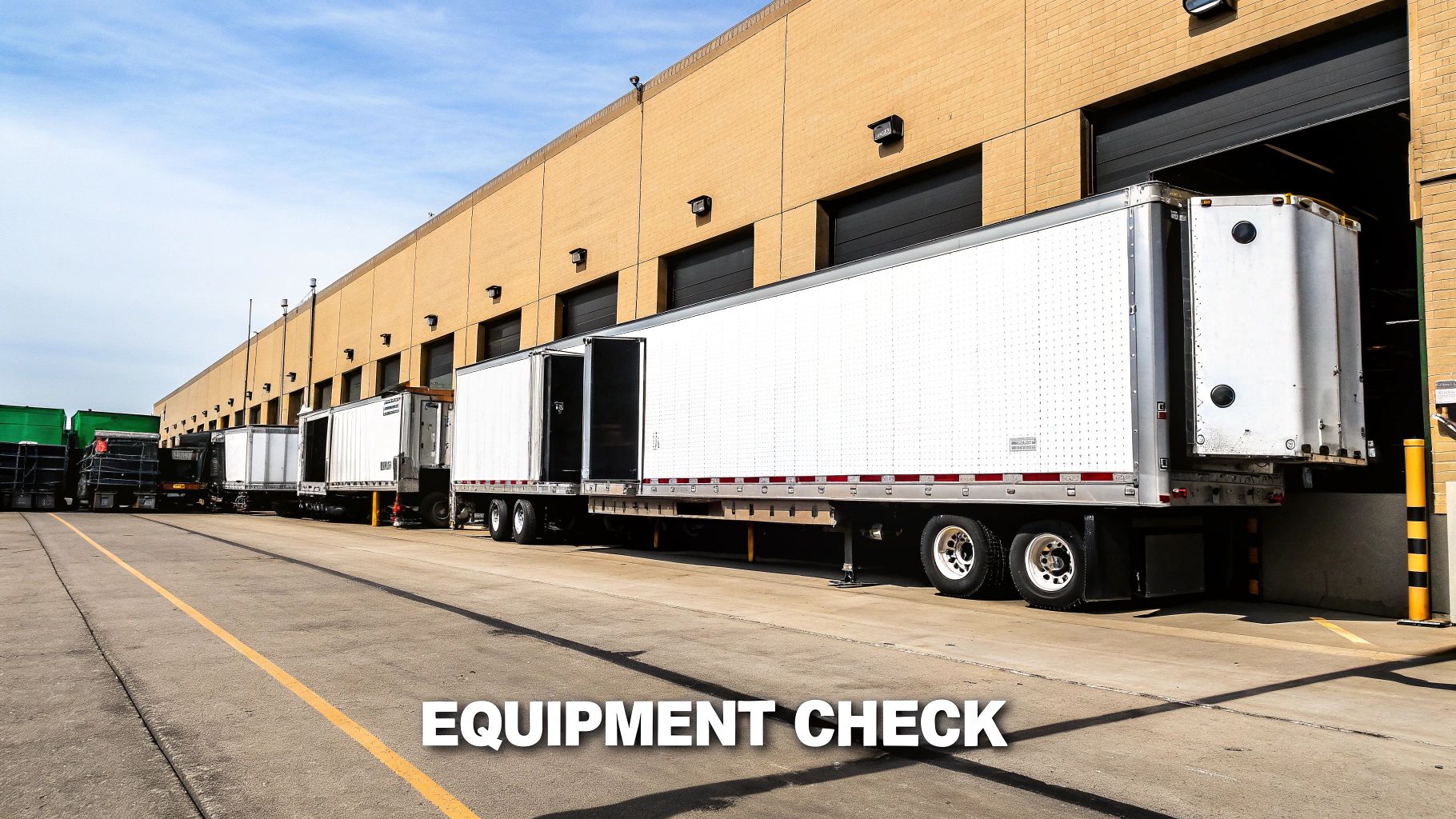
Long before a single permit is even filed, logistics experts get to work on an exhaustive route survey. This isn’t a quick drive-by. It's an on-the-ground intelligence-gathering operation to spot every potential obstacle that could derail the project. The stakes are just too high to leave anything to chance.
A proper survey meticulously checks a long list of potential hazards. Why? Because a single miscalculation can lead to catastrophic damage, crippling delays, and massive fines. It’s a process that combines sophisticated software with good old-fashioned, real-world verification.
Here’s what they’re looking for:
Modern route planning for heavy haul is a pretty sophisticated operation. Logistics teams start with specialized software that maps out potential routes based on known restrictions and infrastructure data. But technology only gets you so far.
The real expertise comes from combining that digital plan with on-the-ground intelligence. This is where experience really shines. A seasoned planner knows that a bridge might be rated for a certain weight, but recent construction or temporary restrictions might not be updated in a database yet.
This physical verification—what we call "ground truth"—is what separates a good plan from a flawless one.
A planned route is a promise of safety and compliance. It's the assurance that every potential physical and legal obstacle between point A and point B has been identified, analyzed, and solved before the journey even begins.
This painstaking process is all about avoiding the nightmare scenarios: a truck wedged under a bridge, a collapsed road, or a shipment impounded because it's on an unapproved route. It’s a high-stakes game where winning is the only option.
Figuring out the price of a heavy haul load isn't as simple as looking at a standard per-mile rate. It’s more like putting together a complex puzzle. The final quote is a blend of several moving parts, and each one—from your cargo's size to the route it has to take—adds a piece to the final picture.
Unlike a typical LTL or FTL shipment with fairly predictable pricing, heavy haul costs reflect the enormous amount of planning and specialized work involved. Every extra foot of width or ton of weight brings new challenges, and those challenges have a price tag. These aren't just random fees; they're the real costs of getting the job done safely, legally, and on time.
Let's pull back the curtain on the main factors that drive the price of moving heavy haul loads. Getting a handle on these will show you exactly where your money is going.
The total cost of a heavy haul shipment reflects the value of a complete logistics solution. It covers not just the transportation itself, but also the expert planning, regulatory navigation, and risk management required to move your valuable asset safely.
Beyond the big four, a few other things can nudge your final quote up or down. These usually have to do with the unique details of your shipment and the conditions on the ground.
Insurance and Liability
To fully grasp the financial side of heavy haul, it's essential to understand the role of commercial auto insurance. The cargo is incredibly valuable, and so is the specialized equipment moving it. That means carriers have to carry rock-solid insurance policies, and those high premiums are a necessary business cost that gets factored into the shipping rate. It protects everyone from the huge risks involved.
Route Complexity and Urgency
A route through winding mountain passes or a congested city is a completely different beast than a straight shot across the plains of Kansas. Tricky routes burn more fuel, demand more from the driver, and slow things down—all of which bumps up the cost.
Need it there yesterday? An urgent timeline can limit routing options or require rush processing for permits, which also adds to the price. For a deeper dive into how these factors play out, our guide on heavy equipment shipping rates offers some great examples.
The market itself has its say, too. U.S. domestic shipping costs can swing from $3 to $8 per mile, depending on all these variables. And with North America holding a massive 35% of the global heavy equipment transport market as of 2023, you can see just how high the demand for these expert services is.
See how these factors apply to your specific shipment by getting a transparent, no-obligation quote today.
Let's be blunt: the single most important decision you'll make when shipping heavy haul loads is choosing your logistics partner. This isn't like booking a standard truckload. You're handing over a multi-ton, high-value piece of equipment to a team that needs to be part project manager, part navigator, and part safety officer, all rolled into one.
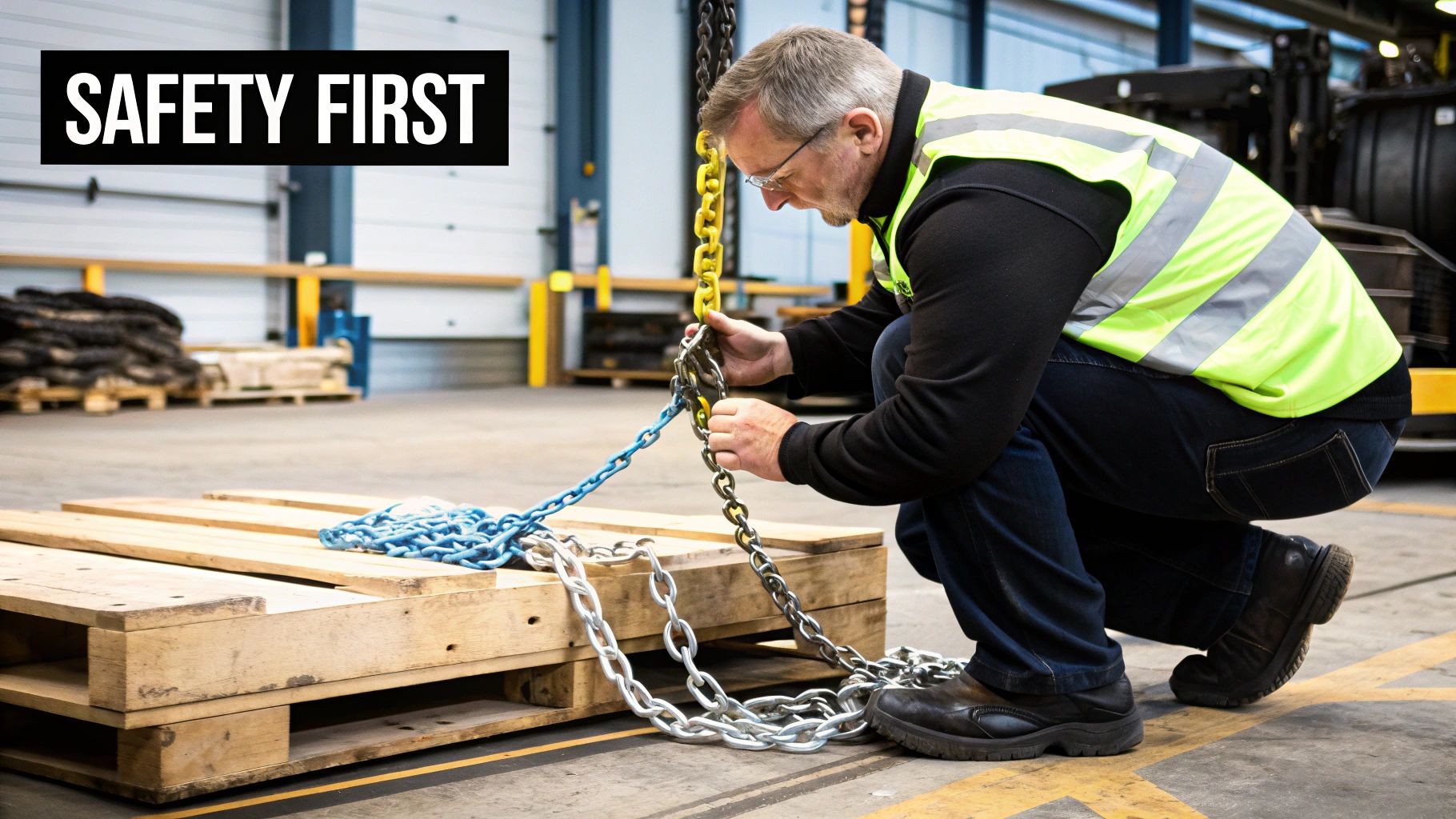
Getting this choice wrong can be a nightmare. We're talking catastrophic delays, eye-watering fines, or even damage to your cargo. But the right partner? They make the entire process smooth, compliant, and surprisingly stress-free.
When you start looking at different companies, you need to vet them like you're conducting a high-stakes job interview. There are a few things that are absolutely non-negotiable. Don't even think about compromising on these.
Here’s your essential checklist:
Ready to see what a reliable partner can do for your next shipment, whether it's FTL or LTL?
Beyond the basics, the best heavy haul partners bring a whole other level of expertise and service to the table. These are the qualities that tell you your valuable freight is in the best possible hands.
A top-tier partner doesn’t just move your freight; they manage the entire complex ecosystem surrounding it. They anticipate problems, handle the endless paperwork, and communicate proactively every step of the way.
Look for a provider who offers true end-to-end management. This means they handle literally everything—from the initial route survey and securing all the right permits to coordinating pilot cars and making sure the correct multi-axle trailer shows up right on time.
Finally, insist on proactive communication. You should never be left wondering where your shipment is or what's happening. A great partner gives you a single point of contact and provides regular, meaningful updates. That's what gives you real peace of mind.
Even after getting the basics down, it's totally normal to have a few more questions rattling around. The world of heavy haul is full of nuances and specific rules, so let's clear up some of the most common things shippers ask. My goal is to make sure you feel completely confident before your next big move.
This is a big one, and the answer is pretty straightforward: the more notice, the better. You can't just book a heavy haul move the same day like you might with a standard truckload. These projects are a different beast entirely and require some serious upfront planning.
For a pretty typical oversized load, giving your logistics partner two to four weeks of lead time is a solid benchmark. That gives them enough runway to survey the route, line up all the state-by-state permits, and book the right specialized truck and trailer. But if you're dealing with a true "superload," the planning phase could easily stretch over several months.
Your standard cargo insurance policy almost certainly won't cut it here. The value and risk involved in heavy haul are just too high. Any carrier worth their salt will have heavy-duty insurance policies that cover the full value of your expensive cargo and their specialized equipment.
Here’s what you should be looking for:
Don't be shy about asking for a certificate of insurance. A reputable partner will hand it over without you even having to push for it. It's your right to verify their coverage before your valuable asset hits the road.
Do you have a standard LTL or FTL shipment that needs a fast, reliable quote? We can help with that, too.
You bet. Any modern logistics provider will have real-time GPS tracking on their trucks. This gives you a live look at where your shipment is from the moment it leaves to the moment it arrives. For high-value assets, that kind of transparency isn't just nice to have—it's essential for peace of mind.
It’s easy to mix these up, but they play very different roles in keeping a shipment safe.
Pilot cars, also called escort vehicles, are regular cars or trucks driven by certified pros. Their whole job is to act as the eyes and ears for the truck driver—clearing a path, warning other drivers, and spotting low-hanging wires or tight turns ahead.
A police escort, on the other hand, is the real deal—actual law enforcement officers. They're usually only required for the most massive "superloads." Police have the authority to do things pilot cars can't, like stop traffic, shut down roads, and navigate the convoy through tricky city centers. The permits issued by each state will spell out exactly which type of escort your specific load needs to have.